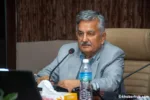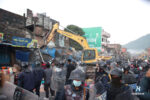KATHMANDU: Finance Minister Barsha Man Pun encountered a relatively smooth process in presenting the annual fiscal budget in Parliament on May 28.
Despite the budget’s increase by 6.2 percent compared to the unrevised budget of the current fiscal year, concerns arise regarding the apparent contradiction in aiming to inject Rs1.86 trillion into the economy to achieve a 6 percent growth rate while capping inflation at 5.5 percent, as pointed out by some economists.
They emphasize the critical importance of prudent money supply management, highlighting the risks associated with a money supply growth rate outpacing the economy’s capacity to produce goods and services, potentially fueling inflationary pressures anticipated in the upcoming fiscal year.
The government’s allocation of funds, with 61.31 percent earmarked for recurrent spending, 18.94 percent for capital expenditure, and 19.74 percent for financing, reflects its strategic fiscal priorities.
Revenue generation strategies encompass a mix of sources, including taxation, foreign grants, and both external and internal loans.
Despite concerns over slowing growth this year, the budget engenders hope, particularly with initiatives like the industrial corridor, which is expected to alleviate economic challenges by bolstering industrial output.
However, critiques remain regarding the budget’s clarity in addressing the cooperative crisis and operationalizing new airports, highlighting uncertainties amidst the political landscape.
In a bid to support migrant workers and foster entrepreneurship, the government plans to provide free orientation training for those going abroad for work and launch a ‘returnee entrepreneurship programme,’ targeting self-employment for at least 100,000 individuals.
The government’s increase in capital expenditure is seen as a promising step towards economic reform, with a renewed focus on stimulating growth, encouraging private sector investment, and enhancing agricultural productivity.
Equally concerning is the relative balance compared to government policies and programs and the lack of clarity regarding the resolution of the cooperatives crisis and the absence of a coherent vision for operating new airports in Pokhara and Bhairahawa.
The budget’s ambitious goals can be challenging to achieve amidst the uncertain political climate.
Finance Minister Pun has emphasized the budget’s focus on three key areas of reform: addressing slow economic growth, revitalizing private sector investment and confidence, and enhancing agricultural productivity.
The government also aims to attract foreign direct investment by signing the Double Taxation Avoidance Agreement with other countries.
Finance Minister Pun outlines the government’s broader objectives, including Nepal’s graduation from the ranks of Least Developed Countries (LDCs), meeting Sustainable Development Goals by 2030, and achieving middle-income country status by the same year.
He underscores the importance of employment generation through private sector investment and skills-based learning initiatives.
The government’s announcement of an investment decade in the agriculture sector is accompanied by specific measures, such as interest subsidies, technical support, and tax waivers for commercial farming ventures.
Additionally, provisions for insurance premium waivers and soft loans aim to support individuals and firms engaged in aromatic rice production. There are also plans to explore commercial farming of wild animals like musk deer in mountainous regions.
The budget’s focus on promoting innovation through initiatives like the agriculture investment decade, science and technology decade, and women’s empowerment decade, are seen as fundamental for economic transformation.
However, equally challenging is to achieve the targeted economic growth rate amidst the current crisis and the absence of concrete measures to address the economic slowdown.
The budget has envisioned a transformative shift in Nepal’s energy landscape, with plans to revolutionize production by adding 900MW to the national grid and reaching a total generation capacity of 4,500MW in the upcoming fiscal year.
The annual spending of the three tiers of government pales in comparison to the private sector’s contribution, highlighting its pivotal role in driving economic growth.
Additionally, the government aims to elevate per capita electricity usage to 450 units and kickstart the construction of several reservoir-based projects, including the Budhi Gandaki, Dudh Koshi, Nalgadh, and Naumure hydropower projects, to meet dry season demand.
The ambitious agenda includes initiating the construction of the Sunkoshi III hydropower project and integrating 100MW of solar projects from the private sector into the national grid.
In a bid to support migrant workers and foster entrepreneurship, the government plans to provide free orientation training for those going abroad for work and launch a ‘returnee entrepreneurship programme,’ targeting self-employment for at least 100,000 individuals.
Additionally, steps will be taken to establish consumer courts to address market malpractices, alongside provisions for loans and concessions in technical education and medical fields.
To bolster tourism, the government aims to attract 1.6 million foreign tourists by promoting Nepal as a wedding destination and leasing government lands for hotel and resort construction.
Furthermore, initiatives are underway to enhance Nepal’s presence in the information technology sector, with targets set for IT-related exports and job creation.
Acknowledging private sector input, the budget incorporates suggestions such as the formation of a high-level reform commission and the promotion of contract farming.
Despite economic challenges exacerbated by the pandemic and geopolitical dynamics, there needs to be political stability by prioritizing economic considerations to avert further downturns.
The delays in budgetary processes are one of the major concerns that need a focused and proactive approach to governance and economic policymaking.
Despite economic reforms in the 1990s promising a liberal market-based economy, successive governments have shown limited favor towards private businesses.
The prevalence of crony capitalism can even distort the efficiency of a free market and benefit only a select few individuals, families, and communities.
Protecting these interests perpetuates power struggles in politics, undermining the hopes and aspirations of the broader population.
Despite post-disaster growth spurts, political instability and haphazard decision-making have hindered sustained economic progress. Economist Acharya highlights the detrimental effects of unstable politics on bureaucracy, which in turn impacts the economy, underscoring the urgent need for political stability and consistent policymaking to foster long-term economic growth and prosperity.
On the other hand, the prevailing political uncertainty surrounding the budget’s presentation raises concerns about its method of enactment—whether through ordinances or common consensus—and undermines its ability to achieve its objectives.
Despite Nepal’s private sector contributing over 80 percent to GDP, the fragile political system has deterred investors, leading to decreased investment.
The annual spending of the three tiers of government pales in comparison to the private sector’s contribution, highlighting its pivotal role in driving economic growth.
It requires an urgent need to encourage private investment to spur economic growth, warning that without such efforts, Nepal will remain stuck in a low-growth trap.
Meanwhile, the private sector has been reiterating the need for a stable bureaucracy and policies, suggesting that frequent changes in government would be tolerable if policies remained consistent as the fiscal budget serves as a policy document to steer the economy and stresses the importance of stable policies and their effective implementation.
Despite post-disaster growth spurts, political instability and haphazard decision-making have hindered sustained economic progress. Economist Acharya highlights the detrimental effects of unstable politics on bureaucracy, which in turn impacts the economy, underscoring the urgent need for political stability and consistent policymaking to foster long-term economic growth and prosperity.









Comment